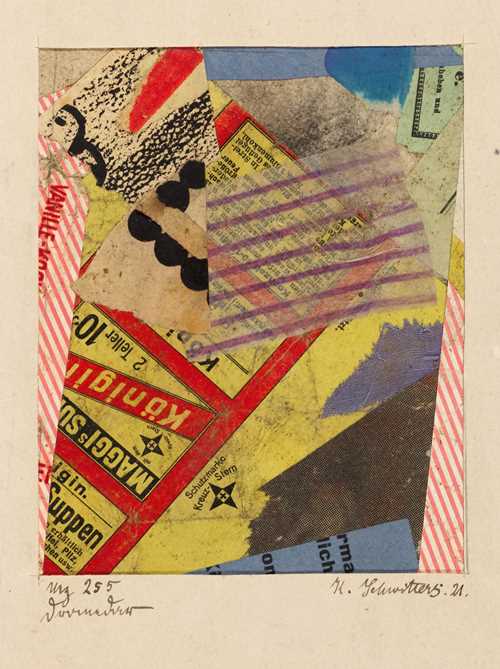
Lotto 3258 - A201 Impressionismo e arte moderna - venerdì, 01. luglio 2022, 17h00
KURT SCHWITTERS
Insribed on the reverse: Mz 255 300.
- Wilhelm Uhde, Paris, 1921 (on view).
- Private collection Germany, acquired probably in Dresden in the 1920s.
- Swiss private collection, by descent from the above over several generations to the present owner and since its acquisition owned by the same family.
Literature:
Karin Orchard and Isabel Schulz: Kurt Schwitters, Catalogue Raisonné 1905–1922, Hatje Cantz 2000, vol. 1, p. 403, no. 846.
“I called my new manner of working from the principle of using any material MERZ. That is the second syllable of Kommerz [commerce]. It originated from the Merzbild [Merzpicture], a picture in which the word MERZ, cut-out and glued-on from an advertisement for the KOMMERZ- UND PRIVATBANK [Commercial and Private Bank], could be read in between abstract forms. The word MERZ had become a part of the picture by being attuned with the other parts, so it had to stay there. […] So I named all my pictures as a species MERZbilder after the most characteristic one. Later I expanded the title Merz, first to include my poetry, […] and finally to all my relevant activities. Now I call myself MERZ” (Elderfield, 1986, p. 13).
In 1919 Germany found itself in a time of upheaval. It was shortly after the First World War, the country was experiencing hyperinflation, revolution and counter-revolution. Inspired by Der Sturm and the simultaneous Dada movement, Schwitters founded his own "one-man" avant-garde in Hanover, which he summarily declared the MERZ revolution. Schwitters started working with collage at that time. It was the beginning of his MERZ pictures. For Schwitters, his collages and assemblages were an artistic revolution in which art and life merged through the combination of refuse and found objects of modern life into new, glorified forms. As his neighbour in Hanover recounted, "a crazy, original genius-character, carelessly dressed, absorbed in his own thoughts, picking up all sorts of curious stuff in the streets... always getting down from his bike to pick up some colourful piece of paper that somebody had thrown away” (Steinitz, 1968, p. 68). From these found fragments, Schwitters constructed poetic constellations that expressed a new formal language and pointed to a hidden order within the apparent chaos of the times.
Executed in 1921, “Mz 255 Dromedar” is a marvellous example of Schwitters’ MERZ collages. Shortly after its creation in the 1920s, the work was acquired in Germany by ancestors of the current owner and has been in the family's private collection ever since. This sheet, which is listed as lost in the catalogue raisonné, is a beautiful rediscovery.
CHF 60 000 / 90 000 | (€ 61 860 / 92 780)
Venduto per CHF 79 600 (incl. premio dell'acquirente)
Non si assume alcuna responsabilità per la correttezza di queste informazioni.



